To an inexperienced eye, Ephesus might look like just another collection of ruins – but it’s like a time machine, taking you back to the time when Ephesus was a place of power, commerce, and culture.
It was once home to over 250,000 people, one of the largest cities in the Roman Empire and one of the most important cities of the ancient world.
About the Site
The Archaeological Site of Ephesus, located on Turkey’s Aegean coast, is one of the most well-preserved and historically significant ancient cities in the world. A major center of culture, trade, and religion, Ephesus thrived under Greek and Roman rule, serving as the capital of Roman Asia Minor.
The city’s iconic landmarks include the Library of Celsus, the Grand Theatre, and the remains of the Temple of Artemis, once one of the Seven Wonders of the Ancient World.
As an early center of Christianity, Ephesus is also linked to St. Paul and the Virgin Mary, adding to its historical and religious significance. Recognized as a UNESCO World Heritage Site, Ephesus continues to draw visitors eager to walk its marble streets and experience its timeless legacy.


Key terms explained
Asia Minor: Asia Minor, or Anatolia, is a vast peninsula in modern-day Turkey, historically serving as a crossroads for civilizations including the Hittites, Greeks, Romans, and Byzantines. Its strategic location between Europe and the Middle East made it a center for trade, culture, and empire-building throughout history.
Celsus: Tiberius Julius Celsus Polemaeanus was a Roman senator, consul in Rome (92 CE), and proconsul of Ephesus (105–107 CE), overseeing public buildings and amassing great wealth. The Library of Celsus was built as a grand memorial and burial site in his honor, reflecting his status as one of Ephesus’ most influential figures.








